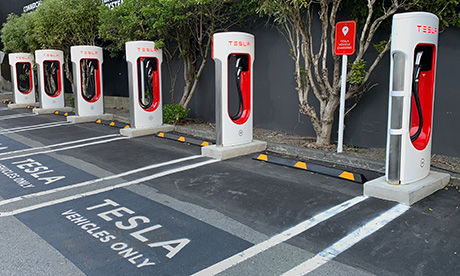The number of electric vehicles on the world’s roads is surging, hitting a record number last year.
That would seem to be good news, as the world tries to wean itself off fossil fuels that are wrecking the global climate. But as electric cars become more popular, some question just how environmentally friendly they are.
The batteries in electric vehicles, for example, charge on power that is coming straight off the electric grid — which is itself often powered by fossil fuels.
And there are questions about how energy-intensive it is to build an EV or an EV battery, versus building a comparable traditional vehicle.
Are electric vehicles greener?
The short answer is yes — but their full green potential is still many years away.
Experts broadly agree that electric vehicles create a lower carbon footprint over the course of their lifetime than do cars and trucks that use traditional, internal combustion engines.
Last year, researchers from the universities of Cambridge, Exeter and Nijmegen in The Netherlands found that in 95% of the world, driving an electric car is better for the environment than driving a gasoline-powered car.
Electricity grids in most of the world are still powered by fossil fuels such as coal or oil, and electric vehicles depend on that energy to get charged. Separately, EV battery production remains an energy-intensive process.
Four years ago New Zealand had a 90% rate of renewable energy, but now only 70% of New Zealand’s energy is from renewable sources. In 2021 New Zealand is in effect burning dirty imported coal to keep the lights on and charge electric vehicles.
A study from the Massachusetts Institute of Technology Energy Initiative found that the battery and fuel production for an EV generates higher emissions than the manufacturing of an automobile. But those higher environmental costs are offset by electric vehicles superior energy efficiency over time.
In short, the total emissions per mile for battery-powered cars are lower than comparable cars with internal combustion engines.
“If we are going to take a look at the current situation, in some countries, electric vehicles are better even with the current grid,” Sergey Paltsev, a senior research scientist at the MIT Energy Initiative and one of the study’s authors, told CNBC.
Paltsev explained that the full benefits of electric vehicles will be realized only after the electricity sources become renewable, and it might take several decades for that to happen.
“Currently, the electric vehicle in the U.S., on average, would emit about 200 grams of CO2 per mile,” he said. “We are projecting that with cleaning up the grid, we can reduce emissions from electric vehicles by 75%, from about 200 (grams) today to about 50 grams of CO2 per mile in 2050.”
Similarly, Paltsev said MIT research showed non-plug-in hybrid cars with internal combustion engines currently emit about 275 grams of CO2 per mile. In 2050, their projected emissions are expected to be between 160 to 205 grams of CO2 per mile — the range is wider than electric vehicles because fuel standards vary from place to place.
Decarbonization is the process of reducing greenhouse gas emissions produced by burning fossil fuels. Efforts to cut down pollution across various industries are expected to further reduce the environmental impact of EV production and charging over time.
“When you look forward to the rest of the decade, where we will see massive amounts of decarbonization in power generation and a massive amount of decarbonization in the industrial sector, EVs will benefit from all of that decarbonization,” Eric Hannon, a Frankfurt-based partner at McKinsey & Company, told CNBC.
Batteries are the biggest emitter
EVs rely on rechargeable lithium-ion batteries to run.
The process of making those batteries — from using mining raw materials like cobalt and lithium to production in gigafactories and transportation — is energy-intensive, and one of the biggest sources of carbon emissions from EVs today, experts said.
Gigafactories are facilities that produce EV batteries on a large scale.
“Producing electric vehicles leads to significantly more emissions than producing petrol cars. Depending on the country of production, that’s between 30% to 40% extra in production emissions, which is mostly from the battery production,” said Florian Knobloch, a fellow at the Cambridge Centre for Environment, Energy and Natural Resource Governance.
Those higher production emission numbers are seen as “an initial investment, which pays off rather quickly due to the reduced lifetime emissions.”
China currently dominates battery production, with 93 gigafactories producing lithium-ion battery cells versus only four in the U.S., the Washington Post reported this year.
“I think the battery is the most complicated component in the EV, and has the most complex supply chain,” George Crabtree, director of the U.S. Department of Energy’s Joint Center for Energy Storage Research, told CNBC, adding that the energy source used in battery production makes a huge difference on the carbon footprint for EVs.
Batteries made in older gigafactories in China are usually powered by fossil fuels, because that was the trend five to ten years ago, he explained. So, electric vehicles that are built with batteries from existing factories are going to have large carbon footprints.
But that’s changing, he said, as “people have realized that’s a huge carbon footprint.” Continue reading
